
India is ready to witness another record harvest of winter-sown crop as cold weather and rainfall in main grain-producing regions of northern India are likely to improve yields of wheat, pulses and oilseeds.
S K Malhotra, Agriculture commissioner told media that the weather conditions in many states that includes Haryana, Punjab, Rajasthan and Uttar Pradesh have been very favourable for crops, which will increase food production to a new high. He said, “Conditions are ideal for wheat, pulses and oilseeds, which are in the developing stage at this moment. Cold conditions with light showers will increase the yield and the only precaution is, water should not stand in the field”.
As per the latest rabi sowing data released by the ministry of agriculture, wheat acreage that accounts for more than half the sown area is up over 11 percent to 32.646 million ha, due to a rise in planting in Rajasthan, Madhya Pradesh, Maharashtra and Gujarat. The total rabi sown area has also increased to 62.5 million ha - 8 percent more than 57.847 million ha planted during this time in previous year.

The surge in sowing is also supported by better availability of water in reservoirs across India. The latest Central Water Commission report showed that 120 key reservoirs have a cumulative storage of 30.28 billion cubic metre (BCM) of water, that is around 53 percent more than 85.04 BCM recorded previous year. He said, “If conditions remain ideal, this year will have a record wheat production and if strong winds, heavy rains & hailstorms don’t strike the crop during harvesting stage in February & March”.
India, in the last season had produced a record 116.42 million tonnes (MT) of rice & 102.19 MT of wheat. Oilseeds output stood at 32.25 MT and the pulses production was 23.40 MT. However, the government is concerned with the production of kharif crop, which has been badly hit because of late monsoon followed by erratic & excessive rains in several parts of Maharashtra, Madhya Pradesh, and Karnataka.
In addition, government’s first advance estimates of kharif this year also shows a slight drop in harvest. But, ground reports suggest that the output could suffer a shortfall of least 10-12 percent.















